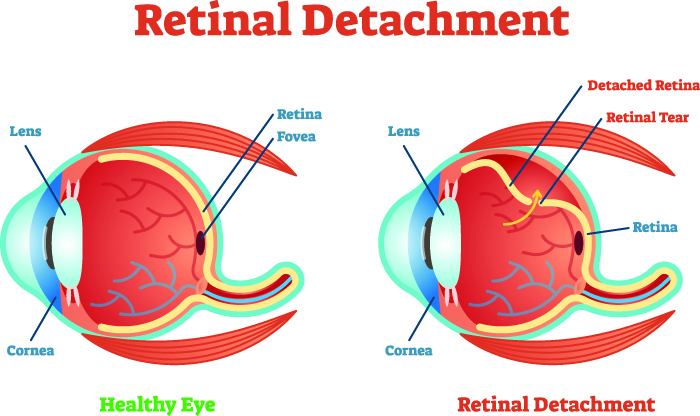Retinal detachment Treatment in Kondapur, Hyderabad
Retinal detachment is a disorder of the eye where the retina of the eye gets separated from its original position. Retinal detachment is a rare disorder with less than 10 lakh cases every year.

What are the types of retinal detachment?
There are generally three types of retinal detachment;
- Rhegmatogenous retinal detachment: this type of retinal detachment occurs when the retina slightly breaks. It is also called a retinal tear.
The break in the retina allows fluid to pass from the vitreous space into the subretinal space. The breaks in the retina are further divided into three types- tears, dialysis and holes. Tears form due to vitreoretinal traction. Dialysis is formed due to retinal atrophy and holes are formed by retinal atrophy. - Tractional retinal detachment: the tractional retinal arrangement is caused by an injury or inflammation. It pulls out the sensory retina from the retinal pigment epithelium.
- Exudative, serous or secondary retinal detachment: this form of retinal detachment occurs because of injury, inflammation or vascular abnormalities that lead to accumulation of fluid under the retina without any break, hole or tear. In rare cases, exudative retinal detachment may be caused by the growth of a tumour on the tissues that are beneath the retina. The tissues are called choroid and the cancer is named choroidal melanoma.
What are the signs and symptoms of retinal detachment?
Signs and symptoms of retinal detachment may include:
- Brief flashes of light may appear on the outside of the centre part of the vision.
- The number of floaters may increase suddenly
- A ring of floaters in the skull side of the central vision may appear.
- Loss of central vision
- A dense shadow may appear in the peripheral vision and extend to the central vision.
- Straight lines may suddenly appear curve
Request an appointment at Apollo Spectra Hospitals, Kondapur
Call 1860-500-2244 to book an appointment
What are the treatments?
There are usually four methods through which retinal detachment is treated. Although, the four surgical procedures apply almost the same principle and the goal of the surgeries are to mend the breaks of the retina.
Cryopexy and laser photocoagulation: This procedure is occasionally used for walling off a small area in the retinal detachment so that the detachment does not spread any more.
Scleral buckle surgery: In this surgical treatment, the doctor sews the silicon bands (one or more) with the white outer coat of the eyeball. Then the bands of the retina push the wall of the retina inwards against the retinal hole.
Pneumatic retinopexy: This surgery is performed to repair the retinal detachment by injecting a gas bubble into the eye and later the laser or freezing treatment is given in the retinal hole. This surgery is performed by general or local anaesthesia.
Vitrectomy: Vitrectomy is the most common treatment for retinal detachment at Apollo Kondapur. In this treatment, the vitreous gel is removed and later the eye is filled by a gas bubble or silicone oil.
These treatments of retinal detachment have an 85% of success rate in one operation while the other 15% of cases need two or three operations to get successful. After this treatment, the patients usually regain their vision in a few weeks. Sometimes, the visual acuity may not be as good as it was before the treatment.
No, retinal detachment may not cause pain due to which many people face problems in identifying retinal detachment when they already have it.
That is why looking over the signs and symptoms of retinal detachment and consulting a doctor is important before the case becomes severe.
It is important to treat the retinal detachment because if left for a long time then it may cause loss of vision, so the sooner the better.
Also, the sooner the surgery is performed the better are the visual outcomes of the surgery.
No, retinal detachment needs immediate treatment for good results. The treatment includes the surgical methods that help to reattach the retina to the back of the eye and restore blood supply to the retina, which the eye won’t be able to do on its own.
The occurrence of retinal detachment depends and varies from person to person. It may be caused due to an injury or trauma to the eye or due to advancement in age.
Symptoms
Our Top Specialities
NOTICE BOARD
CONTACT US
CONTACT US
 Book Appointment
Book Appointment


.svg)
.svg)
.svg)
.svg)








